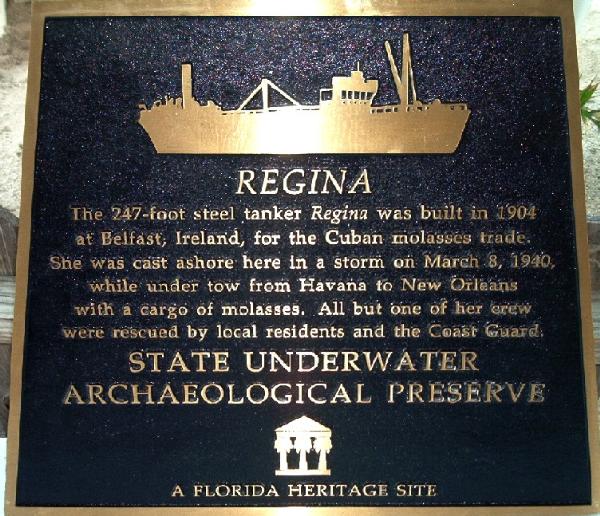Florida Underwater Museum: Regina Sugar Barge Wreck - SHALLOW SHORE DIVE - Dive Site Map of Florida & Bahamas from www.ScubaLessonsInc.com (sitios de interés)
Descripción del sitio

Regina was a steel steamer built in 1904 in Belfast, Ireland, by the Workman, Clark & Co. shipyard for the Cuban Molasses Transportation Co., based in Havana. She was 247 ft. in length, with a 36 ft. beam, a 14 ft. draft, and was rated at 1,155 gross tons with a net tonnage of 669. Designed with a single deck and a single propeller powered by a triple-expansion steam engine producing 850 hp., the steamer also was rigged as a schooner for auxiliary power, and fitted with electric lighting.
Regina joined a growing fleet of large and small tankers carrying a specific liquid cargo: molasses. Shipped from several locations in Cuba, the Dominican Republic, and Puerto Rico to ports on the East and Gulf Coasts of the United States, molasses was used primarily by rum distilleries, and also by animal feed manufacturers. New Orleans was a principal port of the world’s molasses trade; cargoes were transferred to river barges for distribution inland to feed producers in the Midwest. Compared with other liquid cargoes carried by tankers at sea, such as oil, chemicals, or fresh water, molasses is much heavier. In cold weather it thickens, becoming difficult to pump during transfer and requiring a longer time in port. Various tank-heating methods were used to make the cargo more fluid and easier to pump.
Converted to a tanker barge, Regina left Havana on March 5, 1940, under tow by the tugboat Minima, bound for New Orleans with a cargo of more than 300,000 gallons of molasses. Two days later, a cold front swept across the Gulf of Mexico from the northwest, accompanied by 8 to 12-foot seas, gale force winds, and freezing temperatures. The tugboat altered course toward the shelter of Tampa Bay, but before she could reach safety, her tow lines parted near Egmont Key and Regina drifted helplessly toward Anna Maria Island. In the late afternoon on Friday, March 8, the converted tanker grounded in heavy seas on a sand bar off Bradenton Beach. Pounded by the surf and wind, the vessel began to crack and break apart as nighttime approached. Regina’s crew of eight stayed aboard the stranded tanker, afraid to abandon ship in such turbulent conditions. As word of the disaster spread, local residents gathered on the darkened beach, where they built fires to reassure the crewmen that they had been seen.
The following morning, a small bi-wing seaplane arrived from the St. Petersburg Coast Guard Station. Unable to land in the still-stormy seas, it dropped lifejackets and supplies, but they were washed ashore by the waves and wind. The plane continued to circle over the wrecked tanker, and soon was joined by a second airplane from the station. The Coast Guard cutter Nemesis arrived, but could not approach Regina due to the shallow depth of the water. The crowd of spectators watched helplessly from shore as one of the crewmen, later identified as Seferino Canneciras, attempted to swim ashore but disappeared in heavy surf about 100 yards from land. Later that morning as the storm subsided, a Coast Guardsman and two volunteer boatmen, Clayton Adams and Furman Smith, rescued Capt. José Urquida, Ernesto Crusostino, José García García, Leonard Perez, and Angel Lopez. Two other crewmen, Benjamin Alfonso and Juan León, swam the 500 yards to shore on their own.
Regina was a total loss; her cargo of molasses drained into the gulf and her stranded, battered hull became part of the underwater landscape. Today, more than sixty years of pounding surf have left the tanker a sunken hulk, partially buried under sand, but her remains are teeming with sea life. Locally known as the “Sugar Barge”, this wreck is popular with scuba divers and snorkelers due to its proximity to the beach and its vibrant tropical fish.



|
Water Type: Ocean
Salinity: Salt Access: Shore Maximum Depth: 20 Typical Visibility: Poor (11-25 ft) Wreck or Submerged Object?: Ship/boat Underwater Life: Spadefish, Stone Crab, Goliath Grouper, Sheepshead For a virtual experience on this site visit: http://www.museumsinthesea.com/regina/index.htm |
